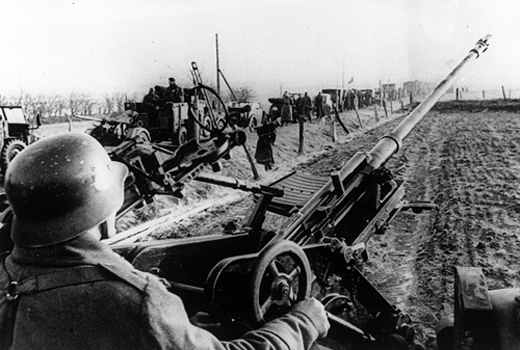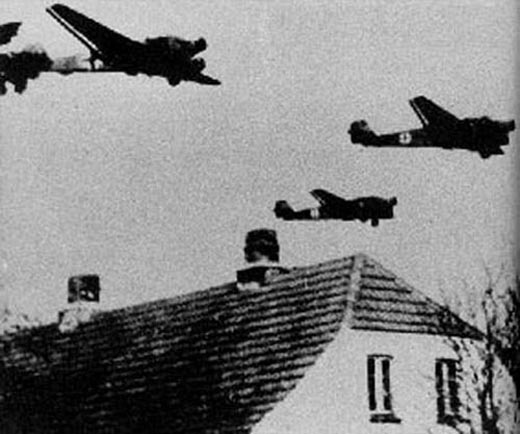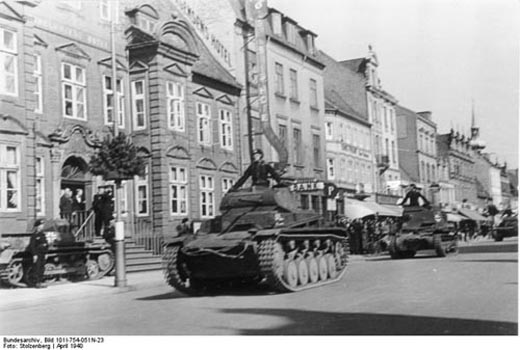Denmark The German XXXI Corps of 2 German divisions under the command of Gen Leonard Kaupisch invade Denmark. The landings are made at Copenhagen, Aalborg Airfield, Esbjerg and other towns. The Jutland-Funen Bridge is seized. Danish troops offer some resistance in southern Jutland and the Royal Guard makes a brief stand at Amalienborg Palace in Copenhagen. Copenhagen is taken within 12 hours. Me-110s strafe Vaerlose Airfield, HQ of the Danish Air Force, destroying many planes on the ground. There is no resistance from the Danish Navy. The casualties for the Danish army are 13 dead and 23 wounded. The Germans suffer 20 casualties.
German Anti-aircraft Gun
|
 |
|
German Transport Planes
|
 |
|
Some Danish Soldiers on Bicycles
|
 |
|
|
[ | |   ] ]
Norway The German landings begin. Germany extends the war claiming it has 'documentary proof that England and France has jointly decided to carry out their action through the territory of the Northern States against the will of the latter. . . .Germany has thus preserved the Scandanavian countries and peoples from destruction, and will until the end of the war defend true neutrality in the North'.
German occupation forces are embraced by Norwegian pro-Nazis led by Vidkun Quisling, whose name from here on becomes synonymous with traitor. Quisling proclaims himself prime minister, although even he is surprised by the swiftness of the German actions. The landings occur at Oslo, Kristiansand, Stavanger, Bergen, Trondheim and Narvik. The group of ships intended for Oslo meet increasing resistance as they sail up the Oslo Fiord. At the Oscarsborg Narrows the brand-new heavy cruiser Blücher is sunk by Norwegian coastal batteries claiming 1,600 lives. The troops are compelled to land below this point but are, however, soon in the town. Airborne units take some casualties in a simultaneous landing at Oslo's Fornebu Airport. King Haakon VII and most of the cabinet and parliament (together with the country's gold reserves) escape by train to Hamar, 70 miles north of Oslo. Fog disrupts the German landings at Kristiansand but eventually the troops get ashore. At Stavanger the vital Stavanger-Sola airfield is quickly taken by airborne attack but much of the airborne force's equipment is sunk offshore by a Norwegian destroyer.
BlŁcher Sinking in Oslofjord near DrÝbak, Norway
|
 |
|
|
|
German Tanks in Denmark
|
 |
|
|
|
At Bergen surprise is also achieved but the cruiser Konigsberg is damaged by a coastal battery. To the north, Trondheim is taken practically without a shot. The most questionable part of the German plan is the move on Narvik. By a combination of luck and bad weather they pass the British patrols en route and once up the fiord quickly sink 2 old coast-defense ships, the Eidsvold and the Norge. It is felt that the Norwegian garrison at Narvik is betrayed by its commander, Col Sundlo, a member of the Quisling's rebellious pro-German faction. Offshore there is an engagement between the battlecruiser Renown and Scharnhorst and Gneisenau in which, despite the disparity of force, Gneisenau is damaged before the German ships break off the action. A British destroyer force is on the way to Narvik. Off Kristiansand the cruiser Karlsruhe is sunk by the British submarine Truant. Overall the Germans have succeeded brilliantly in getting their forces ashore and their hold on Stavanger airport will prove crucial later in the campaign. As the British Home Fleet approached Bergen, they are attacked by German land-based aircraft and forced to withdraw. 47 Ju-88s and 41 He-111s are involved in the attacks. The battleship Rodney and 3 cruisers are damaged. The destroyer Gurkha is sunk.
German Soldiers Reach Norway
|
 |
|
|
[  | |   ] ]
|





